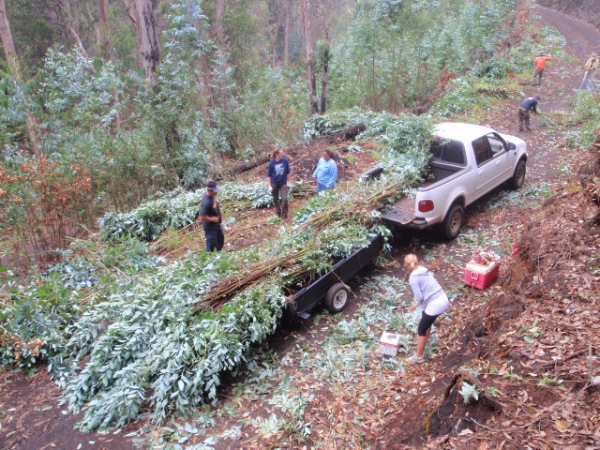
Crews harvest saplings of invasive eucalyptus for use in a sculpture by artist Patrick Dougherty. The sculpture is at the Hui No'eau Art Center in Makawao. Photo by Rose Gabriel
One day I was pulling a weed and I realized there was a little grain of hostility there toward this invasive plant,” said Washington D.C. artist, Patterson Clark, in an interview with National Public Radio. “And I stopped and thought: I don’t want to be this way in nature. I don’t want to be in an adversarial mode when I’m in nature. How can I change my attitude to make this more of a positive experience? And the word ‘harvest’ came to mind.” Patterson shifted his perspective and began turning weeds into resources — brushes, inks, and even paper.”
It’s happening throughout the country — artists, chefs, hunters, and fisherman are using their talents to harvest invasive plants and animals, transforming them in innovative ways–each example regionally appropriate. In the Southeast, artists weave kudzu into lampshades, baskets, and sculpture. In the Pacific Northwest, printmakers are making paper out of Japanese knotweed. In Maryland, the forest-choking vine, oriental bittersweet, is morphing into lighthearted sculpture. In some places, it’s work you can sink your teeth into. “Invasivores” control pests by dining upon them: Asian carp, Himalayan blackberries, even nutria, the semi-aquatic rodent that invades the wetlands of the South, can be dinner. Fishing derbies have tapped into the competitive spirit, controlling venomous lionfish in Florida and removing voracious roi from Hawaii’s reefs. This month, on the lawn of the Hui No’eau art center, sculptor Patrick Dougherty will be twisting watershed-choking strawberry guava into imaginative shapes.

The best an invasive species can look! This sculpture on display at the Hui No'eau Visual Arts Center was made out of strawberry guava, eucalyptus, and white ash. Photo by Hui No'eau.
Many of the plants and animals that overrun our environment have useful attributes: they taste good, have beautiful wood or nice flowers. But the value of the species may come at a high cost– the health of an ecosystem, quiet nights, locally grown produce or livestock.
By harvesting (or overharvesting!) these invaders we can recycle unwanted species while helping the environment. The carbon footprint of using locally available material is less than importing it from the mainland and the process provides a connection with the land while giving back to the place we live.
There are risks. Invasive plants and animals carry a reputation for jumping the fence and escaping. Keep the following points in mind when using invasive materials and you’ll help ensure that your work is making a difference, but not planting the seeds of a new invasion, literally and figuratively.
How does this species spread? Tiny seeds, resilient vegetative roots? If you are going to move an invasive species, be sure to bag the flowers and fruit, and make sure fruit, flowers, and roots are disposed of properly (not Green Waste!).
- Toxic invaders: Many species have chemicals harmful to people and animals. Research the species and how it can safely be used. Roi are toxic to eat, every part of oleander is toxic, and the sap of some plants, like the pothos vine, can cause a bad skin rash.
- Do you have permission? Check with the landowner before removing any species.
- Is it legal? State laws restrict the transport of some plants and animals. Some species are on the noxious weed list or targets for control by local invasive species committees. Check with them for guidance.
Finally, remember to stay slightly detached from the material which, ideally, will become harder and harder to find. Perhaps then it will be time to find a new invasive to work with. It’s unlikely that a hunting tournament, new recipe, or art sculpture will lead to the eradication of an invasive plant or animal, but by harvesting invasive species you’re helping restore balance to the ecosystem.
So by all means, jump in. Lend a hand to control invasive plants and animals. Cook with ‘em, carve, weave, or sculpt them, mash a weed into paper, or even turn your project into a contest! Tell people why and what you are doing. Just be extra careful you’re not accidentally making the problem worse.
For more information on the sculpture at the Hui visit their website and check out the day-by-day building of the sculpture entitled On The Wild Side at their blog.
Dining on invasive species? Check out invasivore.org for recipes.
By Lissa Fox. Originally published in the Maui News, September 11, 2011 as part of the Kia‘i Moku Column.Check out all of the MISC articles in the Kia`i Moku series at: www.hear.org/misc/mauinews/

Thank you for speaking up for my beloved strawberry guava.